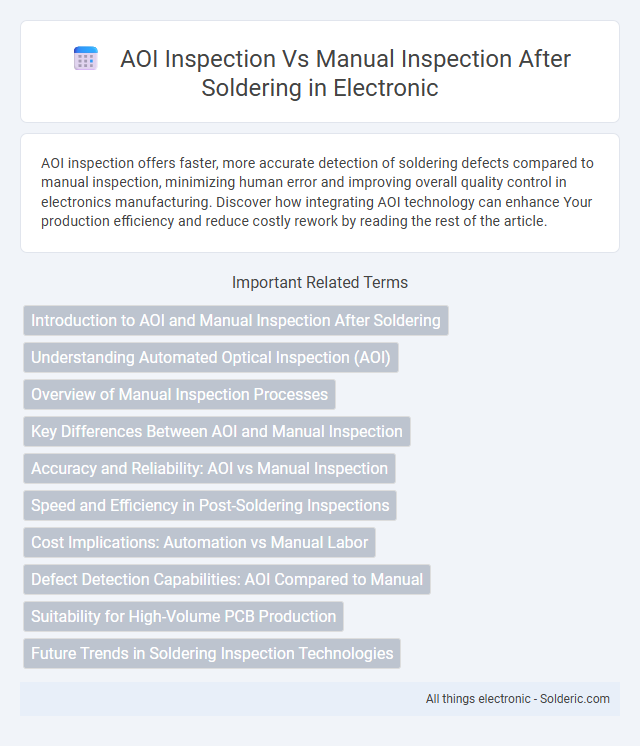AOI inspection offers faster, more accurate detection of soldering defects compared to manual inspection, minimizing human error and improving overall quality control in electronics manufacturing. Discover how integrating AOI technology can enhance Your production efficiency and reduce costly rework by reading the rest of the article.
Comparison Table
| Criteria | AOI Inspection | Manual Inspection |
|---|---|---|
| Accuracy | High; detects soldering defects with precision | Moderate; dependent on inspector skill and attention |
| Speed | Fast; automated scanning and processing | Slow; time-consuming manual evaluation |
| Consistency | Consistent; repeatable results without fatigue | Variable; affected by human fatigue and bias |
| Cost | High initial investment; low operational cost | Low initial cost; higher labor expenses over time |
| Defect Types Detected | Solder bridges, insufficient solder, misalignment | Visual defects, obvious soldering issues |
| Operator Skill Requirement | Moderate; requires programming and calibration | High; requires experienced inspectors |
| Scalability | High; suitable for mass production | Low; limited by human resources |
Introduction to AOI and Manual Inspection After Soldering
Automated Optical Inspection (AOI) utilizes high-resolution cameras and advanced algorithms to rapidly detect soldering defects such as bridging, insufficient solder, or misalignment, ensuring precise quality control in electronics manufacturing. Manual inspection after soldering relies on human vision and judgment to identify defects but is often slower and less consistent compared to AOI systems. Your production line benefits from AOI's efficiency and accuracy, reducing errors and improving overall solder joint reliability compared to manual inspection methods.
Understanding Automated Optical Inspection (AOI)
Automated Optical Inspection (AOI) uses high-resolution cameras and advanced image processing to detect soldering defects with precision that surpasses manual inspection. Unlike human inspectors, AOI consistently identifies issues such as solder bridges, insufficient solder, and component misalignments, enhancing overall quality control. Your manufacturing process benefits from faster inspection cycles and reliable defect detection, reducing rework and improving product yield.
Overview of Manual Inspection Processes
Manual inspection after soldering involves visual examination by trained technicians who check for defects such as solder bridges, incomplete joints, and misalignments using magnification tools like microscopes or magnifying glasses. This process relies heavily on human experience and subjective judgment, making it time-consuming and prone to inconsistencies, especially in complex or high-volume production environments. Despite its limitations, manual inspection allows for nuanced detection of subtle defects that automated systems might miss, but it often results in lower throughput and higher labor costs compared to AOI inspection systems.
Key Differences Between AOI and Manual Inspection
Automated Optical Inspection (AOI) uses high-resolution cameras and software algorithms to detect soldering defects with greater speed and accuracy, reducing human error and ensuring consistent quality control. Manual inspection relies on human inspectors to visually examine solder joints, which can be slower and less reliable due to fatigue and subjective judgment. You can enhance quality assurance by incorporating AOI for efficient defect detection while reserving manual inspection for complex cases requiring expert evaluation.
Accuracy and Reliability: AOI vs Manual Inspection
Automated Optical Inspection (AOI) delivers superior accuracy compared to manual inspection by using high-resolution cameras and advanced algorithms to detect soldering defects such as bridges, cold joints, and insufficient solder with minimal human error. AOI systems provide consistent reliability through repeatable, objective analysis, reducing the variability introduced by manual inspectors who may experience fatigue or subjective judgment inconsistencies. The combination of rapid defect identification and data logging in AOI enhances traceability and process control, outperforming manual inspection in maintaining high-quality standards after soldering.
Speed and Efficiency in Post-Soldering Inspections
AOI inspection drastically reduces the time required for post-soldering quality checks by automating the detection of defects such as solder bridges, misalignments, and insufficient solder joints. Manual inspection is significantly slower due to its reliance on human visual assessment and is prone to variability and fatigue, which can impact accuracy and efficiency. By integrating AOI into your post-soldering process, you can achieve faster throughput and more consistent inspection results, ultimately improving overall manufacturing productivity.
Cost Implications: Automation vs Manual Labor
AOI inspection dramatically reduces costs by minimizing manual labor, increasing inspection speed, and improving defect detection accuracy after soldering. Manual inspection requires more workforce hours, leading to higher labor expenses and increased risk of human error, which can result in costly rework or part failures. Investing in AOI technology ultimately lowers total production costs while ensuring consistent quality control in your manufacturing process.
Defect Detection Capabilities: AOI Compared to Manual
AOI inspection offers superior defect detection capabilities compared to manual inspection after soldering, consistently identifying issues such as solder bridges, tombstoning, and insufficient solder joints with higher accuracy. Automated Optical Inspection uses advanced imaging technology and pattern recognition algorithms, reducing human error and fatigue that commonly affect manual inspection. Your production quality improves significantly with AOI, ensuring early detection and minimizing costly rework or product failures.
Suitability for High-Volume PCB Production
AOI inspection is highly suitable for high-volume PCB production due to its speed and consistent accuracy in detecting soldering defects, reducing human error and rework rates significantly. Manual inspection, while useful for complex or subtle defects, is time-consuming and less efficient for large-scale runs, leading to potential delays and increased labor costs. Your production line benefits from integrating AOI to maintain quality control without sacrificing throughput in mass manufacturing environments.
Future Trends in Soldering Inspection Technologies
AOI inspection is rapidly advancing with AI-driven defect detection and real-time analytics, surpassing manual inspection in speed and accuracy post-soldering. Emerging trends include 3D imaging and machine learning algorithms that enhance detection of subtle solder joint flaws, enabling predictive maintenance and reduced rework rates. Integration with Industry 4.0 systems is expected to streamline production workflows, ensuring higher yield and consistent soldering quality in electronics manufacturing.
AOI inspection vs manual inspection after soldering Infographic

 solderic.com
solderic.com